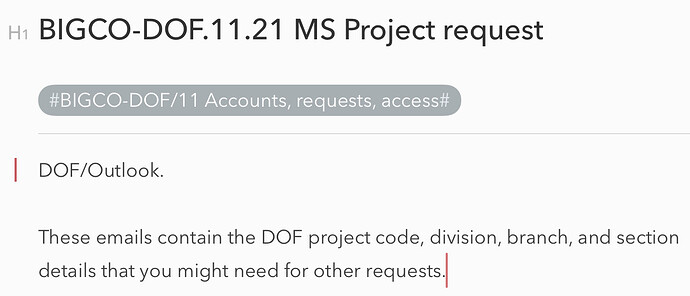My work situation is one single project/system, which I use across multiple domains/computers. Let’s say I work for consulting company BIGCO and the government department whose project we are executing is the Department of Fun, DOF.
The numbers are all intermixed. I have 26 Communications and that includes a weekly project status pack to my stakeholder that’s produced on my BIGCO laptop. It’s 26.01. Its master version is in the BIGCO Teams shared area, but then I email it out every week and get comments/queries by email so they live in BIGCO > Outlook > 26.01. (Yes, I create numbered folders in Outlook. For everything.)
Then I have another comms pack that contains sensitive DOF data — server names, IP addresses, the sort of thing we usually keep on the network — and it only exists in the DOF Teams area. It’s 26.06 and again might have an Outlook folder.
These are all real examples. Another: I have category 11 Accounts, requests, access that collects all those things. 11.01 might be the setting up of my DOF account, 11.02 is about my security pass at BIGCO, 11.03 is my request for MS Project, and so on. These items are scattered around my world but I don’t care! I have an index which tells me where they are.
How do I do that? Easy: every index item looks like this. (This is a real one, which I’ve obfuscated.)
I use Bear’s hashtags, which are hierarchical. You get a nice sidebar of clickable tags. The first line in each note is always the location of the thing. In this case, I submitted a request and the response came via email so that’s where that thing is.
Then I have some notes, which is me helping future me with keywords. I know at some point I’ll want to look up my ‘division’ or ‘branch’ again, and this request has them. I’ve already used this to help someone else raise a similar request.
With my index, I found my old request in ~5 seconds. Literally seconds. I open Bear, hit Cmd-Shift-F, type a couple of words, and there it is. People watch over my shoulder and literally exclaim out lout. “Wow … how did you do that?”
(And by the way, I could grab that screenshot without moving from my kitchen table where I’m having my morning tea because my index is synchronised to this iPad. From anywhere I can immediately tell you if I have a thing, and where it is. I make sure that the contents of the notes don’t contain anything sensitive.)
You could do this without an index, but in this situation I’d consider it essential. And look at how simple it is: it’s just a note. That note took me less than a minute to create. It’s not some heavy operation and I’ve already been paid back in the time that it took.
I think I’ll make the new website page for ‘the index’ really clear that if you have a single system in a single place then maybe you don’t need an index. I think that’s the confusion here. But as soon as it spreads out, which is inevitable in many situations, you need one. No question.
It might be a neat home/work split, but I also use an index at home for other reasons. Basically the same as the scenario above though: I have some things that are only files, some things that are only emails, and some things that are only notes. How would I track those without an index?

